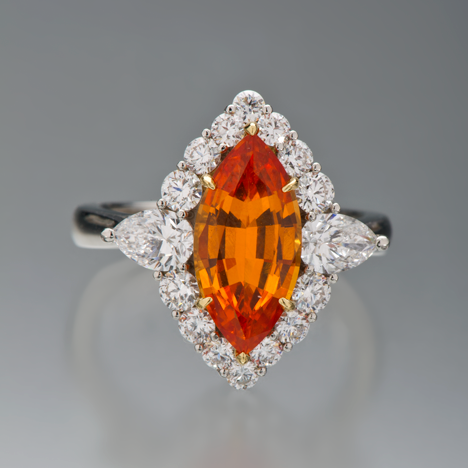Fall Fashion Ideas: Orange Gems

Orange gemstones stand out and shine, adding zest to any wardrobe. Orange gemstones are classic – they have graced fashions for centuries and are always in style.
Consider some orangey-hued gemstones: Sapphire. Garnet. Fire Opal. Topaz. Citrine. Where do they come from? What makes them special? What do they cost? Let’s take a look at a few outrageous oranges, and find out more about these gemstones from the experts at GIA (Gemological Institute of America), the world’s foremost authority in gemology.
Fancy Sapphire, a variety of the mineral corundum, features orange among many appealing hues. An especially alluring orange-pink color is called padparadscha, after the lotus blossom. GIA’s gem experts point out that this latter variety is very rare and ranges from pastels to more fiery shades. The best examples of authentic padparadscha sapphire usually command a premium price, often equal to their fine blue counterparts. Sri Lanka and East Africa are major sources of orange and padparadscha sapphire.
Spessartine Garnet is perhaps the most eye-catching orangey gemstone around. According to GIA’s colored stone experts, it is prized for its bright orangy-yellow to yellowish-orange color, with some of the best – and most sought after – examples mined in Southern California, at the Little Three mine, near Ramona. High-qualilty spessartine has more recently been mined in Namibia and Nigeria.
Mandarin Garnet is a trade name for bright orange spessartine from Namibia. Although relatively inexpensive in small sizes, larger stones (which rarely exceed 10 carats) can fetch significant prices. The rich color of Mandarin garnet makes it a favorite of orange gemstone lovers worldwide.
Fire Opal is an anomaly in the opal family. Opals are usually smoothly polished in a cabochon (domed) shape, mined in Australia, and are opaque (not see-through). But the intriguing fire opal is often found in a fabulous orange color, cut in a faceted manner, mined in Mexico, and is mostly transparent in better quality facet-grades. And it’s also found at favorable prices in jewelry this season.
Topaz is another gemstone that is found in various colors, such as yellow, dark blue, pink, red, and light green, but it truly shines in orange. Fine orange and “imperial topaz” (orange with a hint of red) are among the rarer colors of topaz, and their higher prices reflect their scarcity. This unusual shade is mostly found in Brazil.
Citrine, a variety of the mineral quartz, can appear in an orange shade, called Madeira, although it’s most often seen in one of its yellow coats. Mined mainly in Brazil, citrine is often found in larger sizes, due to its affordable price, and it is easy to find.
There’s no right or wrong when choosing an orange shade or a type of jewelry. Whether your passion is a big pair of earrings in citrine or topaz, a fire opal brooch, a mandarin garnet pendant, or a sapphire centered in a ring, this season’s best look for you could be in shades of orange.
When shopping for gemstones, look for a jeweler who is a Graduate Gemologist or Graduate Jeweler. GIA also offers identification reports on gemstones, including those discussed here, to verify their authenticity.



